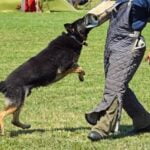Training your dog for bird retrieving can be a rewarding and exciting experience for both you and your furry companion. Whether you are a seasoned hunter or just looking to engage in a fun outdoor activity with your pet, bird retrieving training is a valuable skill to teach your dog. This article will guide you through the process of training your dog to retrieve birds, from the importance of obedience training to advanced techniques for experienced dogs.
Before diving into bird retrieving training, it is essential to lay down a solid foundation of obedience training. A well-behaved and obedient dog will be more responsive to commands during retrieving exercises, making the training process smoother and more successful. By establishing basic commands and behaviors early on, you set the stage for more advanced training techniques later.
In addition to obedience training, selecting the right tools and equipment for bird retrieving is crucial for effective training sessions. From specialized retrieval dummies to long leads for control during retrieves, having the proper gear can make a significant difference in your dog’s learning progress. By understanding the purpose of bird retrieving training and following these fundamental steps, you can set yourself and your dog up for success in this rewarding activity.
Importance of Obedience Training Before Starting Bird Retrieving
Before delving into the specifics of how to train your dog for bird retrieving, it is crucial to emphasize the importance of obedience training as a foundation. Obedience training is essential because it establishes clear communication between you and your dog, making it easier to teach more advanced commands necessary for bird retrieving.
Through obedience training, your dog learns to follow instructions promptly and consistently, setting the stage for successful bird retrieving sessions. Without a solid foundation in obedience, attempting bird retrieving training can lead to confusion and frustration for both you and your furry companion.
One aspect of obedience training that is particularly important before starting bird retrieving is teaching your dog basic commands such as sit, stay, come, and heel. These fundamental commands form the basis of effective communication during bird retrieving exercises. For example, teaching your dog to stay will be vital when you want them to remain in place until given the signal to retrieve a bird.
Likewise, the “come” command is essential for calling your dog back after they have retrieved a bird successfully. By mastering these basic commands through obedience training, you are laying down the groundwork for a successful transition into specialized bird retrieving training.
In addition to basic obedience commands, it is also advisable to work on impulse control with your dog before embarking on bird retrieving training. Impulse control exercises help your dog learn restraint and self-discipline when faced with exciting stimuli like birds or other animals. By teaching your dog to control their impulses early on, you can prevent impulsive behavior during bird retrieving sessions and ensure a more focused and controlled approach to the task at hand.
| Importance of Obedience Training | Before Starting Bird Retrieving |
|---|---|
| Establishes clear communication | Makes it easier to teach advanced commands |
| Prevents confusion and frustration | Sets the stage for successful retrievals |
Choosing the Right Bird Retrieving Training Tools and Equipment
When it comes to training your dog for bird retrieving, choosing the right tools and equipment is essential for success. Here are some key items to consider when preparing for your training sessions:
- Retriever Dummy or Dummy Launcher: These tools are crucial for training your dog to retrieve birds safely and effectively. Make sure to choose a dummy that resembles the size and weight of a real bird to simulate actual hunting scenarios.
- Whistle: A whistle can be used to give commands to your dog from a distance, which is especially helpful in bird retrieving situations where verbal communication may be difficult.
- Treats or Rewards: Positive reinforcement is an important part of training any dog, so make sure to have plenty of treats on hand to reward good behavior during bird retrieving exercises.
In addition to these basic tools, consider investing in a quality harness or vest for your dog to wear during training. This will not only help you control and guide your dog more effectively but also provide protection from rough terrain and potential injuries.
Training With the Right Tools
Utilizing the proper tools and equipment is just as important as knowing how to train your dog for bird retrieving. By incorporating these items into your training routine, you can set yourself and your furry companion up for success in mastering this specialized skill. Remember that patience, consistency, and positive reinforcement are key components of successful bird retrieving training.
Basic Commands to Teach Your Dog for Bird Retrieving
Bird retrieving training requires a solid foundation of basic commands that your dog can easily understand and follow. These commands serve as the building blocks for more advanced techniques that will be introduced later in the training process. One of the most important commands to teach your dog is “sit,” which will help with control and focus during retrievals. Additionally, “stay” is crucial for making sure your dog remains in place until you give them the signal to retrieve.
Another essential command is “come,” which is key for calling your dog back to you after they have successfully retrieved a bird. This command ensures that your dog brings the bird directly to you, rather than running off with it or dropping it prematurely. “Leave it” is also a valuable command to prevent your dog from picking up birds that are not part of a training session or hunting expedition.
Consistency is key when teaching these basic commands to your dog for bird retrieving. Make sure to use positive reinforcement such as treats or praise when they respond correctly, and practice these commands regularly in different environments to reinforce their understanding. With patience and dedication, your dog will soon be ready to move on to more advanced retrieving techniques.
| Command | Description |
|---|---|
| Sit | Helps with control and focus during retrievals. |
| Stay | Makes sure your dog remains in place until given the signal to retrieve. |
| Come | Key for calling your dog back after successfully retrieving a bird. |
| Leave it | Prevents your dog from picking up birds outside of training or hunting. |
Introducing Your Dog to Birds and Building Confidence
Understanding Your Dog’s Instincts
Before diving into bird retrieving training, it is crucial to understand your dog’s natural instincts. Retrievers, spaniels, and other bird dogs have been bred for generations to retrieve game birds. They possess a strong prey drive and an innate desire to chase after moving objects. By acknowledging and working with these instincts, you can set the stage for successful bird retrieving training.
Gradual Exposure to Birds
When introducing your dog to birds, start with small steps to prevent overwhelming them. Begin by incorporating bird feathers into their playtime or training sessions. This can help familiarize your dog with the scent and feel of birds. Gradually progress to using whole dead birds or frozen bird dummies for retrieving practice. Carefully observe your dog’s reactions during these initial encounters and adjust the pace accordingly.
Building Confidence Through Positive Reinforcement
During the process of introducing your dog to birds, focus on building their confidence through positive reinforcement techniques. Use treats, toys, or verbal praise to reward your dog for showing curiosity towards birds or displaying calm behavior in their presence. Encourage small successes along the way, such as approaching a stationary bird dummy or picking up a feather. By creating a positive association with birds through rewards, you can boost your dog’s confidence and enthusiasm for bird retrieving training.
By following these steps and taking time to gradually introduce your dog to birds while building their confidence, you can lay a solid foundation for successful training in bird retrieving techniques. Remember that each dog is unique, so be patient and flexible in adapting your approach based on your pet’s individual needs and progress. With consistency, positive reinforcement, and proper guidance, you will be well on your way to training your furry companion for exciting bird retrieving adventures.
Simulating Realistic Retrieving Scenarios for Training
Setting Up Simulated Retrieving Scenarios
When it comes to training your dog for bird retrieving, it is crucial to create realistic scenarios that mimic actual hunting situations. This can be achieved by setting up scenarios where your dog has to retrieve birds of different sizes and weights in various environments. Start by introducing your dog to dummy birds or training aids before progressing to real game birds.
Practicing Different Retriever Techniques
To prepare your dog for a successful bird retrieving experience, practice different retrieving techniques such as land retrieves, water retrieves, and blind retrieves. Land retrieves involve your dog fetching birds on dry land, while water retrieves require them to swim and retrieve birds from bodies of water. Blind retrieves challenge your dog to find and retrieve hidden birds using their sense of smell and memory.
Adding Distractions and Challenges
As your dog progresses in their bird retrieving training, make sure to add distractions and challenges to simulate real hunting conditions. This can include introducing noise distractions like gunfire or other animals in the area, as well as varying the terrain where the retrievals take place. By exposing your dog to different challenges during training, you will help them develop the skills needed for successful bird retrieving in any situation.
By incorporating these simulated retrieving scenarios into your training routine, you will not only prepare your dog for real hunting expeditions but also strengthen the bond between you and your furry companion. Remember that consistency, patience, and positive reinforcement are key elements in teaching your dog how to retrieve birds effectively. With dedication and proper training techniques, you can transform your canine friend into a skilled bird retriever ready for any adventure in the great outdoors.
Progress Tracking and Adjusting Training Techniques
When it comes to training your dog for bird retrieving, progress tracking and adjusting training techniques are crucial aspects of the process. As you work with your furry companion to develop their skills in retrieving birds, it is important to keep a record of their progress. By tracking milestones, successes, and areas for improvement, you can tailor your training methods to best suit your dog’s needs.
One effective way to track progress is by maintaining a training journal. This journal can include notes on each training session, recording what commands were practiced, how well your dog responded, and any challenges faced during the session. Keeping track of this information will help you identify patterns in your dog’s learning process and make adjustments accordingly.
In addition to progress tracking, it is important to be adaptable in your training techniques. Not all dogs learn at the same pace or respond well to the same methods. If you notice that a certain approach is not yielding the desired results, don’t be afraid to switch things up.
Experiment with different commands, tools, or environments to find what works best for your dog. Remember that every pup is unique, so being adaptable in your training will help set them up for success in bird retrieving.
Overall, by diligently tracking progress and remaining flexible in adjusting training techniques as needed, you can effectively train your dog for bird retrieving. Celebrate small victories along the way and stay patient throughout the process. With dedication and a willingness to adapt, you and your canine companion will make great strides in mastering this skill together.
Addressing Common Challenges and Troubleshooting Tips
Training your dog for bird retrieving can be a rewarding experience, but it also comes with its challenges. One common challenge that many dog owners face is the tendency of their dogs to get distracted or lose focus during training sessions.
To address this issue, it is important to work on building your dog’s focus and attention through short, engaging training sessions. Start by practicing basic obedience commands in a distraction-free environment before gradually introducing distractions such as birds.
Another common challenge when training a dog for bird retrieving is getting them to retrieve the birds gently without damaging them. It is essential to teach your dog proper retrieving techniques early on in the training process. Use soft training dummies or bird wings to simulate real bird retrieval scenarios and reward your dog for gentle handling. Additionally, make sure to supervise your dog closely during training sessions to correct any rough handling behavior immediately.
If you are struggling with getting your dog to properly deliver the retrieved birds to you, consider using positive reinforcement techniques such as treats and praise. Teach your dog a reliable “release” command so they understand when they are supposed to give you the bird without hesitation. Consistency and patience are key when addressing delivery challenges in bird retrieving training. With time and practice, your dog will improve their retrieving skills and become a reliable hunting companion.
Advanced Bird Retrieving Techniques for Experienced Dogs
Once your dog has mastered the basic commands and is comfortable retrieving birds in training scenarios, you may want to consider advancing their skills with more challenging techniques. Here are some advanced bird retrieving techniques for experienced dogs:
- Blind Retrieves: This technique involves sending your dog to retrieve a bird that they have not seen fall. This advanced skill requires excellent trust between you and your dog, as they must rely solely on your hand signals or whistle commands to locate the bird.
- Marked Retrieves with Distractions: Introduce distractions such as other dogs, loud noises, or moving objects to simulate real hunting situations. This will test your dog’s focus and obedience while retrieving birds amidst various distractions.
- Water Retrieving: If you plan on waterfowl hunting, it is essential to train your dog for water retrieves. Teach them to enter the water confidently, swim towards the bird, and bring it back to shore. Use floating decoys or dummies to practice this skill.
As you progress with advanced bird retrieving techniques, remember to maintain a positive reinforcement training approach. Reward your dog for successful retrievals and provide encouragement during challenging tasks. Consistency and patience are key when teaching these more complex skills.
Training Tip
Keep training sessions short and enjoyable to prevent burnout and maintain your dog’s enthusiasm for retrieving birds. End each session on a positive note with a successful retrieve or command execution.
Tracking progress is still crucial in advanced training stages. Keep notes of your dog’s performance, areas for improvement, and any adjustments made in training techniques. Regularly evaluate their skills and adapt training methods accordingly to address any challenges that may arise during advanced bird retrieval training.
Conclusion
In conclusion, training your dog for bird retrieving is a rewarding experience that not only enhances your hunting capabilities but also strengthens the bond between you and your furry companion. By following the steps outlined in this article, you can effectively teach your dog the skills needed to excel in bird retrieving tasks.
Remember that patience and consistency are key when teaching your dog how to retrieve birds. Obedience training lays a solid foundation for more advanced retrieving techniques, so be sure to prioritize this aspect before moving on to specific bird retrieving commands.
As you progress through the training process, always celebrate your achievements with your dog. Positive reinforcement is a powerful tool in shaping behavior, so make sure to praise and reward your dog for successfully completing retrieving tasks. With dedication and practice, you and your bird retrieving dog can build a strong partnership based on trust and teamwork.
Frequently Asked Questions
How Do I Train My Dog to Retrieve Birds?
Training a dog to retrieve birds involves patience, consistency, and positive reinforcement. Start by teaching basic commands like “fetch” and “drop it”, then gradually introduce training with bird scents or dummy birds. It’s important to make the training sessions fun and rewarding for your dog.
How Do You Teach a Dog to Retrieve?
Teaching a dog to retrieve requires breaking down the process into manageable steps. Start with getting your dog comfortable with picking up objects and bringing them back to you. Use treats or toys to encourage the behavior, and gradually increase the distance of the retrieves. Consistency is key in reinforcing the desired behavior.
What Is the Easiest Dog to Train for Bird Hunting?
The easiest dog breeds to train for bird hunting are typically those with a strong prey drive, good retrieving instincts, and an eagerness to please their owners. Breeds like Labrador Retrievers, Golden Retrievers, and German Shorthaired Pointers are popular choices for bird hunting due to their natural abilities and trainability.
However, each individual dog is unique, so it’s important to consider their personality and temperament when selecting a breed for bird hunting training.

Welcome to the blog! I am a professional dog trainer and have been working with dogs for many years. In this blog, I will be discussing various topics related to dog training, including tips, tricks, and advice. I hope you find this information helpful and informative. Thanks for reading!





